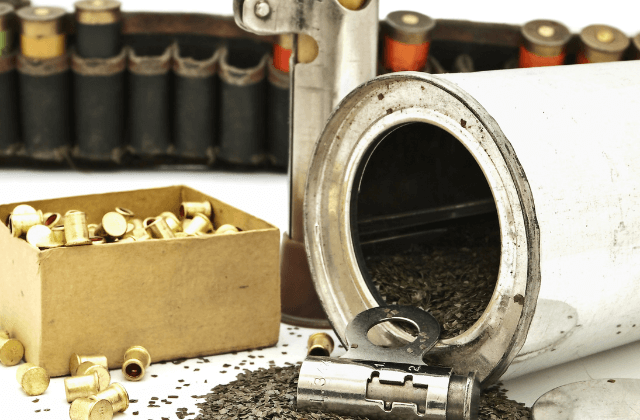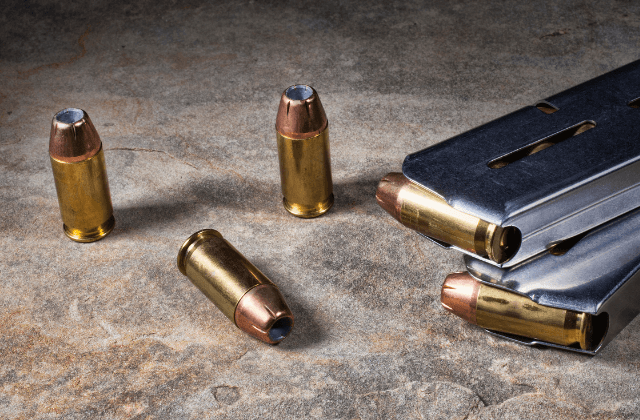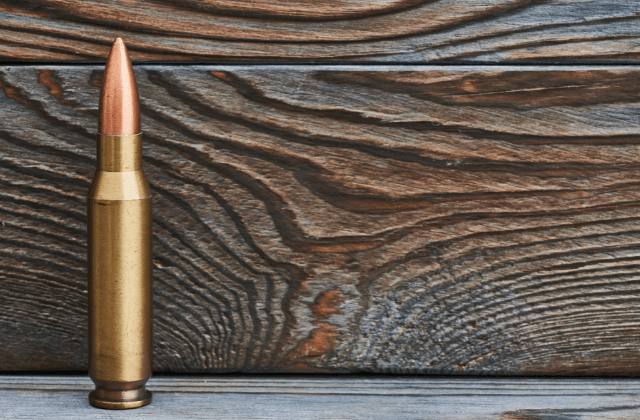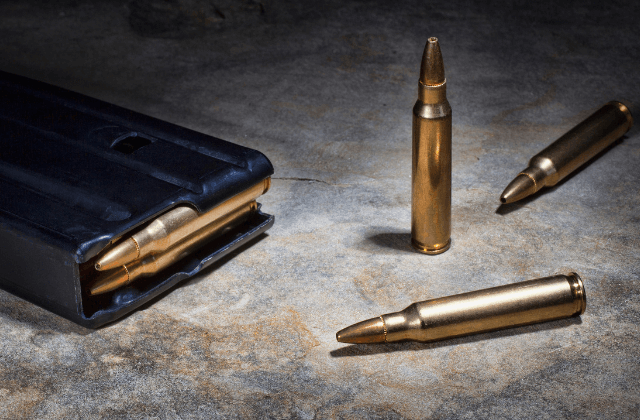This site contains affiliate links. As an Amazon Associate, I earn a commission from qualifying purchases at no extra cost to you. Full Disclosure Here.
Ammunition is a key part of shooting, but the exact mechanics of a round of ammo can be a subject of intrigue and interest for even the most experienced shooters. Today, we’re going to break down just what goes into the ammo that we love so much.
We’re going to look at all the different parts of a single round, as well as some basic information on how they come together to make something greater than each piece.
Ammunition is a fascinating topic that I’ve been interested in for over two decades. So I’m excited to share this with anyone who might be wondering how the bullets in their gun really work and what they’re made of.
What Makes Up Ammunition?
Ammunition is made up of a few basic parts. These include the cartridge, primer, powder, and projectile. In the next section, we’ll go into each of these parts in more detail. For now, let’s just go over the basics of each.

The cartridge, or case, is the part that surrounds the rest of the ammo, holding it all together. The cartridge is made of metal on most handgun and rifle rounds, but on shotgun rounds, it’s usually plastic.
Metal cartridges are sometimes called brass. An entire pre-assembled round of ammunition is also colloquially called a cartridge, so don’t be confused when you hear that usage.
At the base of the cartridge is the primer. When you pull the trigger of your gun, it causes a firing pin or striker to move forward and hit the primer, which ignites and starts the chemical reaction that causes the gun to actually ‘fire.’
That brings us to the next part – the powder. While the primer starts the chemical reaction, the powder adds in energy once it begins to burn too. This causes pressure to quickly build up until it forces forward the last part of the ammunition, the projectile.
On most rounds, there’s only one projectile, called a bullet. On shotgun shells, however, there are a bunch of smaller projectiles called shot.
What are the Basic Parts of Ammunition?
Now that you have a simple understanding of the parts of ammunition and how they work, let’s go into a bit more detail.
First, let’s talk cartridges. As we’ve already said, most cartridges are made of metal. They’re usually made of brass. Since brass can corrode, you’ll sometimes find brass cartridges that are nickel plated for protection against corrosion. For the same reason, you can also find steel or aluminum alloy cartridges, though the latter is only used for rimfire cartridges since it’s not as strong as the other materials.
On rimfire cartridges, the primer is contained within the rim of the case. On centerfire cartridges, the primer is, as you can probably guess, found in the center of the base of the cartridge.

Within centerfire primers, there are two major types: Berdan primers and Boxer primers. You don’t need to worry too much about the difference between these, though, since they feel virtually identical to the shooter.
There are a couple of implications to primer placement. First, rimfire ammunition has lower pressure than centerfire ammunition. Second, centerfire ammunition is much easier to reload than rimfire ammunition.
We’ll talk more about reloading in a moment, but for now, let’s move on to powder.
Powder plays a key role in determining how much power a round has. Generally, more powder means more energy, allowing the round to go farther, faster, and with a flatter trajectory. However, the type of powder also matters.
Different powders have differing burn rates, which can dramatically impact a round’s velocity and energy. This is why some 9mm ammo is rated +P or +P+, for example.
It’s still the same ammo and can be used in most of the same firearms (provided they’re modern guns rated for the extra pressure), but the +P and +P+ ammo will have a more energetic powder charge.
This extra energy can come from the size of the individual powder grains, different chemical mixes of powder, and a host of other things that we don’t really need to get into to know the basics of ammo. All you need to know is that there are a ton of different types of smokeless powders out there.
If you get into reloading, you’ll probably have a favorite, but in general, for most folks, the important thing is going to be those +P and +P+ ratings and the velocity numbers on the back of the manufacturers’ box.
Finally, let’s talk about projectiles. The projectile type that you’ll deal with most frequently is, of course, a bullet.
Like everything else, bullets come in different types, of which the most common are full metal jackets (FMJ) and hollow points. Even though manufacturers might have their own cute names for their particular versions, the vast majority of bullets still generally fall into one of these camps.

FMJs have a soft core completely surrounded by a harder metal case. This makes FMJs more aerodynamic, allowing them to fly faster and with a flatter trajectory. For that reason, FMJs are ideal for AR target shooting. However, they also penetrate deeply, and overpenetration is a risk when using FMJs for hunting or defense.
For those purposes, you want a hollow point. Hollow points have a little hole in the end, allowing the bullet to expand when it hits its target. This rapidly slows the bullet while also causing more tissue damage. When hunting, this helps ensure an ethical single-shot kill, while in defense, it increases the round’s stopping power. However, this comes at the expense of the bullet’s flight. A hole in the front of a bullet isn’t exactly aerodynamic, so hollow points don’t have the same flat trajectory as FMJs.
I also want to briefly mention soft points, a hybrid of the two bullet types we discussed. Soft points have a bullet that’s the same as a hollow point but have soft plastic in that hole to make the bullet more aerodynamic.
This gives soft points a flatter trajectory than hollow points, though not as good as an FMJ. At the same time, soft points expand more than FMJ, though not as much as hollow points. Soft points are good for when you need both penetration and expansion, like for hunting thick-skinned game such as bears or hogs.
With shotgun rounds, you typically have projectiles called shot instead of a bullet. These are smaller pellets of lead contained in a plastic container called a wad or shot cup. This holds the pellets together until the shot leaves the barrel, at which point it opens up and is discarded.
Shotgun shells may also be loaded with slugs or more esoteric projectiles like coins, metal darts, .50 BMG bullets, chains, and other things to produce various effects, but the principle remains the same.
Is it better to buy your ammunition or reload it yourself?
It often depends on your needs and what type of firearm you’re shooting (and in what volume), but reloading your own ammo can provide some serious benefits. This is especially true if you’re doing long-range precision shooting as part of, say, the Precision Rifle Series competition.

For truly high-precision shooting, where every tiny bit of inconsistency can snowball into a major miss at longer ranges, handloading is virtually essential. Factory ammo for such ultra-precise applications will either be very expensive or lack some performance or consistency metric.
That said, getting into reloading is expensive and not something to be taken lightly. You won’t save money by reloading or handloading your own ammo, but you will be able to shoot more for the same amount of money invested.
You can always just buy ammo off the shelf, assuming there’s no shortage, but you will get less for your money than if you reload. Then again, if you don’t shoot a lot and aren’t shooting at longer ranges, you won’t save much by investing in a lot of costly reloading equipment as well.
There’s also the aspect of time. Reloading is a fun hobby to some, but if the actual act of reloading ammo seems like a chore or doesn’t interest you, you might find your time better served by simply buying the ammo outright and not getting into the reloading side of things.
For anyone who really wants to tune their own ballistics, requires a lot of precision, shoots in extremely high volumes, or just wants a new hobby, reloading is a great option. You’ll learn a lot and have some very accurate ammo if you take the time to dial things in.
If you aren’t sure, you can always get a cheap single-stage press and try things out to see if you like it. If the benefits don’t seem worth it, you can sell it or give it to a buddy. If you like it, however, you’ve opened up a new side of the shooting hobby for yourself.
Frequently Asked Questions
While you will sometimes see the two terms used interchangeably, “bullet” refers only to the projectile at the end of the round, while “ammunition” refers to the round as a whole. That said, if you said you were “buying bullets,” most shooters would know what you meant, even if you were technically referring to the whole round.
There are two basic types of ammunition – centerfire and rimfire. Centerfire ammo uses a central primer at the back of the round, which is struck by a firing pin. Meanwhile, rimfire uses a priming substrate that is deposited into the rim of the cartridge, which is then struck by a firing pin.
In terms of what you’re likely to find on store shelves, centerfire pistol and rifle ammo are the most common. This covers everything from big-bore military cartridges like .50 BMG all the way down to pistol-caliber rounds like the beloved 9mm Luger.
Conclusion
Ammunition is a fun topic for shooters and one that some of us easily take for granted. Hopefully, we’ve helped clear the air and shed some light on this very interesting topic. Sadly, like all things in the firearms realm, there’s a lot of hype, confusion, and misinformation out there, but we’re always ready to set the record straight.
Whether you’re a new shooter or an old hand, knowing more about your ammo is never bad, and we’re always happy to help folks learn and grow in this great hobby.

